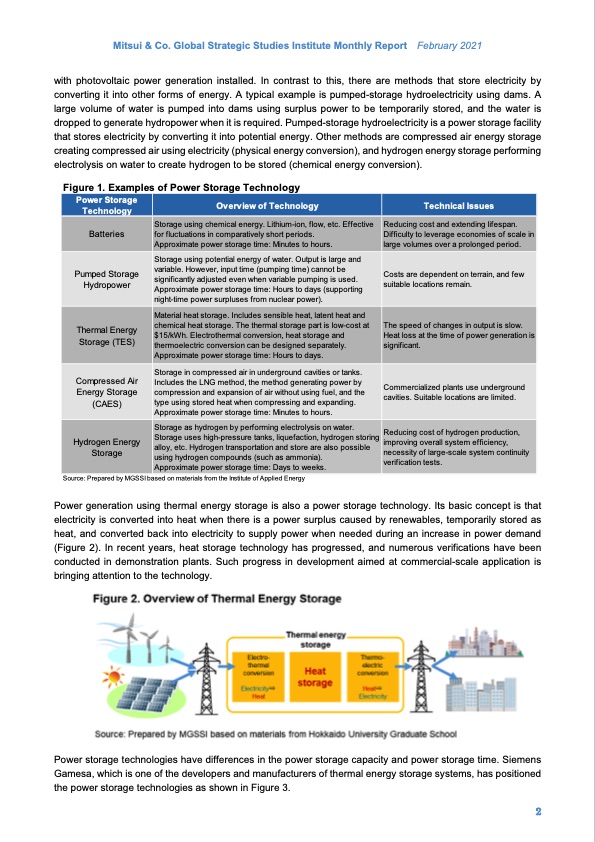
PDF Publication Title:
Text from PDF Page: 002
Mitsui & Co. Global Strategic Studies Institute Monthly Report February 2021 with photovoltaic power generation installed. In contrast to this, there are methods that store electricity by converting it into other forms of energy. A typical example is pumped-storage hydroelectricity using dams. A large volume of water is pumped into dams using surplus power to be temporarily stored, and the water is dropped to generate hydropower when it is required. Pumped-storage hydroelectricity is a power storage facility that stores electricity by converting it into potential energy. Other methods are compressed air energy storage creating compressed air using electricity (physical energy conversion), and hydrogen energy storage performing electrolysis on water to create hydrogen to be stored (chemical energy conversion). Figure 1. Examples of Power Storage Technology Power Storage Technology Overview of Technology Technical Issues Batteries Storage using chemical energy. Lithium-ion, flow, etc. Effective for fluctuations in comparatively short periods. Approximate power storage time: Minutes to hours. Reducing cost and extending lifespan. Difficulty to leverage economies of scale in large volumes over a prolonged period. Pumped Storage Hydropower Storage using potential energy of water. Output is large and variable. However, input time (pumping time) cannot be significantly adjusted even when variable pumping is used. Approximate power storage time: Hours to days (supporting night-time power surpluses from nuclear power). Costs are dependent on terrain, and few suitable locations remain. Thermal Energy Storage (TES) Material heat storage. Includes sensible heat, latent heat and chemical heat storage. The thermal storage part is low-cost at $15/kWh. Electrothermal conversion, heat storage and thermoelectric conversion can be designed separately. Approximate power storage time: Hours to days. The speed of changes in output is slow. Heat loss at the time of power generation is significant. Compressed Air Energy Storage (CAES) Storage in compressed air in underground cavities or tanks. Includes the LNG method, the method generating power by compression and expansion of air without using fuel, and the type using stored heat when compressing and expanding. Approximate power storage time: Minutes to hours. Commercialized plants use underground cavities. Suitable locations are limited. Hydrogen Energy Storage Storage as hydrogen by performing electrolysis on water. Storage uses high-pressure tanks, liquefaction, hydrogen storing alloy, etc. Hydrogen transportation and store are also possible using hydrogen compounds (such as ammonia). Approximate power storage time: Days to weeks. Reducing cost of hydrogen production, improving overall system efficiency, necessity of large-scale system continuity verification tests. Source: Prepared by MGSSI based on materials from the Institute of Applied Energy Power generation using thermal energy storage is also a power storage technology. Its basic concept is that electricity is converted into heat when there is a power surplus caused by renewables, temporarily stored as heat, and converted back into electricity to supply power when needed during an increase in power demand (Figure 2). In recent years, heat storage technology has progressed, and numerous verifications have been conducted in demonstration plants. Such progress in development aimed at commercial-scale application is bringing attention to the technology. Power storage technologies have differences in the power storage capacity and power storage time. Siemens Gamesa, which is one of the developers and manufacturers of thermal energy storage systems, has positioned the power storage technologies as shown in Figure 3. 2PDF Image | THERMAL ENERGY STORAGE DEVELOPING FOR A DECARBONIZED SOCIETY

PDF Search Title:
THERMAL ENERGY STORAGE DEVELOPING FOR A DECARBONIZED SOCIETYOriginal File Name Searched:
2102m_inada_e.pdfDIY PDF Search: Google It | Yahoo | Bing
Turbine and System Plans CAD CAM: Special for this month, any plans are $10,000 for complete Cad/Cam blueprints. License is for one build. Try before you buy a production license. More Info
Waste Heat Power Technology: Organic Rankine Cycle uses waste heat to make electricity, shaft horsepower and cooling. More Info
All Turbine and System Products: Infinity Turbine ORD systems, turbine generator sets, build plans and more to use your waste heat from 30C to 100C. More Info
CO2 Phase Change Demonstrator: CO2 goes supercritical at 30 C. This is a experimental platform which you can use to demonstrate phase change with low heat. Includes integration area for small CO2 turbine, static generator, and more. This can also be used for a GTL Gas to Liquids experimental platform. More Info
Introducing the Infinity Turbine Products Infinity Turbine develops and builds systems for making power from waste heat. It also is working on innovative strategies for storing, making, and deploying energy. More Info
Need Strategy? Use our Consulting and analyst services Infinity Turbine LLC is pleased to announce its consulting and analyst services. We have worked in the renewable energy industry as a researcher, developing sales and markets, along with may inventions and innovations. More Info
Made in USA with Global Energy Millennial Web Engine These pages were made with the Global Energy Web PDF Engine using Filemaker (Claris) software.
Sand Battery Sand and Paraffin for TES Thermo Energy Storage More Info
| CONTACT TEL: 608-238-6001 Email: greg@infinityturbine.com | RSS | AMP |